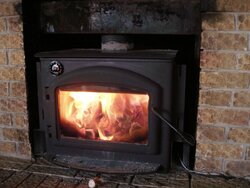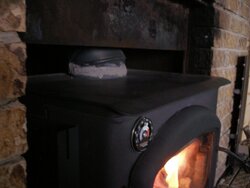Do you guys think it would be beneficial to add a heat shield/deflector to my insert? At the time of the install I did not put a block off plate in. Maybe in the off season I will pull the stove and add one but for now, call me lazy, I really don't want to.
The chimney is roughly 20' tall with 16' being inside the house, directly in the center of the house. It's a huge, massive stone and brick column. So I did not go with an insulated liner. The stove is as far out of the firebox on the hearth as I can get it due to the liner connection.
On days when temps stay above the upper 20's I don't have a need to run the blower. But I feel there might be an opportunity to get even more radiant heat from this thing. I'm envisioning a 2 piece deflector above the stove with a half moon cut out of it to install around the liner. It would sit about 3 inches above the insert and extend over the back and sides to catch as much radiant heat as I could. It would extend outward into the room to meet the steel fire box. Sort of encapsulating the top 1/3 of the stove directing the heat out into the room.
Anyone ever do this? Pics, ideas, comments, other? I know these little blowers don't use much electricity but the less it runs the better.
The chimney is roughly 20' tall with 16' being inside the house, directly in the center of the house. It's a huge, massive stone and brick column. So I did not go with an insulated liner. The stove is as far out of the firebox on the hearth as I can get it due to the liner connection.
On days when temps stay above the upper 20's I don't have a need to run the blower. But I feel there might be an opportunity to get even more radiant heat from this thing. I'm envisioning a 2 piece deflector above the stove with a half moon cut out of it to install around the liner. It would sit about 3 inches above the insert and extend over the back and sides to catch as much radiant heat as I could. It would extend outward into the room to meet the steel fire box. Sort of encapsulating the top 1/3 of the stove directing the heat out into the room.
Anyone ever do this? Pics, ideas, comments, other? I know these little blowers don't use much electricity but the less it runs the better.








